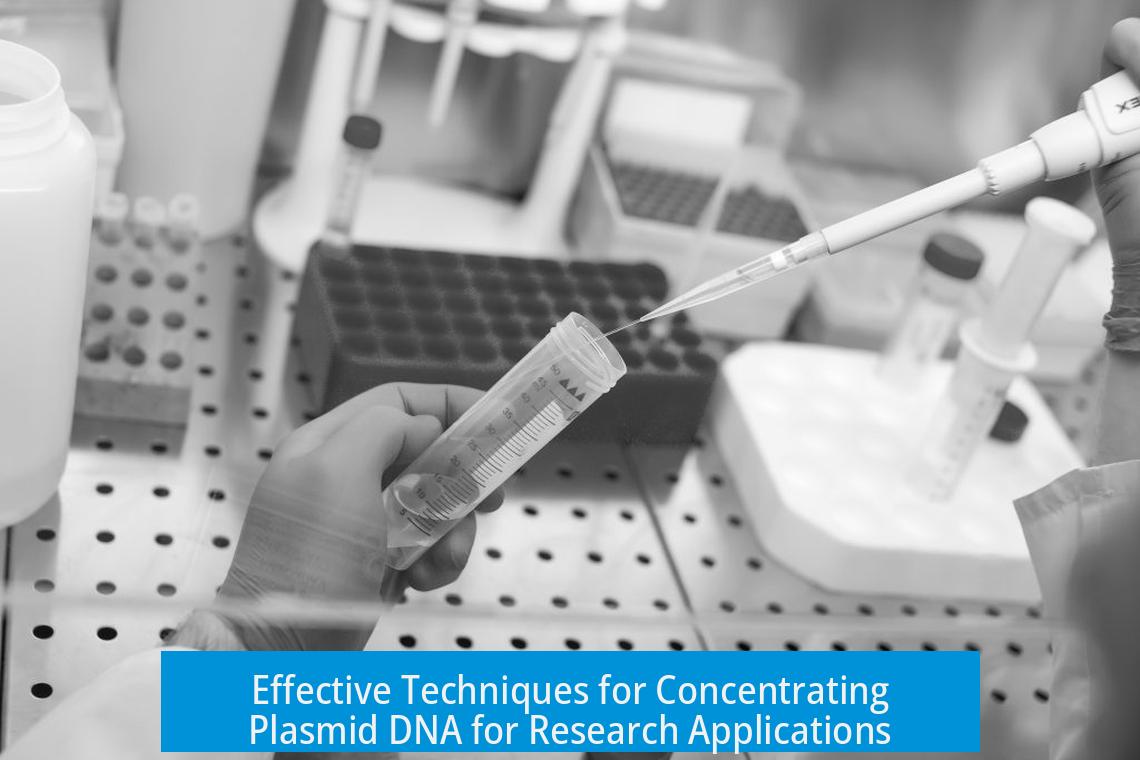Effective Methods to Concentrate Plasmid DNA
Plasmid DNA concentration can be achieved using various methods, including column-based purification with low elution volumes, centrifugal concentrators, precipitation techniques, magnetic beads, and evaporation-based strategies. Each approach offers different advantages depending on the sample volume, DNA quantity, and downstream usage.
1. Column-Based Concentration Techniques
One straightforward way to concentrate plasmid DNA is using commercial PCR clean-up kits. These kits allow DNA to bind to a silica column and elution in minimal volumes such as 20-30 μL. This method increases DNA concentration without complex steps and suits small or moderate volumes.
- Low volume elution: Eluting DNA in smaller volumes from silica columns enhances concentration directly.
- Considerations for elution buffers: Eluting in water facilitates further processes like lyophilization. Buffers containing salts or EDTA may interfere with drying steps.
Spin columns like Amicon Ultra centrifugal filters can concentrate plasmid DNA efficiently by removing excess buffer through centrifugation. This works well for larger initial volumes, although minor DNA losses can occur.
| Method | Advantages | Limitations |
|---|---|---|
| PCR Clean-up Kit & Low Volume Elution | Simple, quick, no special equipment | Limited to small volumes, DNA recovery depends on kit |
| Amicon Ultra Centrifugal Filters | Effective for large volumes, no chemical precipitation | Possible DNA loss, more expensive consumables |
2. Precipitation and Solvent-Based Methods
Traditional DNA precipitation with ethanol or isopropanol concentrates DNA by pelleting it and resuspending in a smaller volume. Adding variations like 2-butanol can reduce aqueous phase volume before precipitation.
- Ethanol/Isopropanol Precipitation: Common, inexpensive, but may require cold incubation and centrifugation.
- 2-Butanol Assisted Concentration: Adding equal volumes of 2-butanol reduces aqueous layer volume to around 25% of original. This is followed by ethanol precipitation or rotary evaporation to recover plasmid DNA.
- Lyophilization: Freeze-drying plasmid DNA in water minimizes volume without adding solvents and avoids precipitation steps.
3. Magnetic Beads-Based Concentration
Magnetic beads such as Beckman Coulter’s Ampure XP allow selective DNA binding. Adding beads at a 1:1 volume ratio to plasmid prep enables DNA immobilization. After washing, DNA is eluted in a volume as low as one-tenth of the original, resulting in significant concentration.
This technique benefits from scalability, purity, and no need for organic solvents, though it typically takes longer due to bead magnetization steps.
4. Evaporation-Based Concentration Approaches
Speedvac concentrators effectively reduce sample volume by evaporation under vacuum and centrifugal force. This method suits small volumes but requires careful temperature control to avoid DNA degradation.
Rotary evaporators (rotovap) are less commonly used for nucleic acids, as their high temperature and vacuum conditions may damage DNA or are less optimal for aqueous solutions compared to Speedvac.
5. Alternative and Less Common Techniques
- Dry Sephadex: Absorbent gel filtration media can adsorb water rapidly, concentrating solutes by decreasing volume. Effectiveness is modest (~3x concentration) and mostly tested with proteins.
- Superabsorbent Polymers: Soil moisture-retention polymers have potential to absorb water and small solutes while retaining large molecules like plasmid DNA. This is speculative and not widely validated.
6. High-Yield Plasmid Preparations to Avoid Post-Purification Concentration
Using high-capacity plasmid prep kits such as Zymo Research’s Maxiprep can yield DNA at concentrations exceeding 3000 ng/μL directly from culture. This circumvents the need to concentrate DNA after purification and ensures clean, usable plasmid samples.
Summary of Methods to Concentrate Plasmid DNA
- Utilize PCR clean-up kits with low-volume elution for small-scale concentration.
- Apply centrifugal concentrators like Amicon Ultra filters for larger volume samples.
- Precipitate DNA with ethanol or isopropanol; consider 2-butanol to reduce solvent volume beforehand.
- Use magnetic beads (Ampure XP) for binding and elution in minute volumes.
- Employ Speedvac for gentle evaporation of small volumes.
- Consider high-yield maxi- or mega-prep kits to avoid concentration steps entirely.
- Alternative methods like dry Sephadex or superabsorbent polymers exist but lack broad validation.
Researchers should select a method based on sample volume, DNA purity requirements, and available equipment. Combining low-volume elution with appropriate concentration techniques often balances yield and simplicity.





Leave a Comment